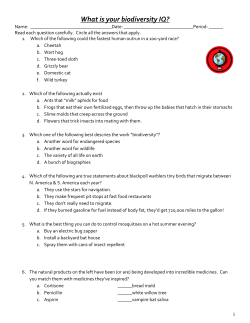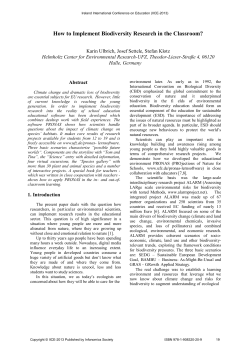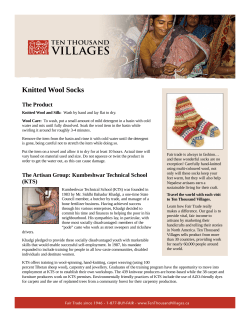
On-farm management of agricultural biodiversity in Nepal
On-farm management of agricultural biodiversity in Nepal Good Practice 9 Community Biodiversity Register: Consolidating community role in management of agricultural biodiversity T raditional knowledge and skills of farmers and indigenous people can make a significant contribution to sustainable development. Empowering community and local institutions to document and use information of their traditional knowledge and biodiversity helps to foster bioprospecting and check biopiracy. The CBR methods are used by diverse types of institutions for different purposes and consequently, methodologies for CBR evolved into different variants. Two distinct types of typology have been emerged: first, inventory of economically valuable biodiversity at the local level and second, strengthening capacity of local community to document important genetic resources and traditional knowledge for developing conservation as well as development plan. What is CBR? Community Biodiversity Register (CBR) refers to “a record, kept in a register by community members, of the genetic resources in a community, including information on their custodians, passport data, agro‐ecology, cultural and use values”. It is also defined as an effort by community to document and conserve both the biodiversity that is used within a given area, and relevant knowledge about it. In recent years, different methods to document knowledge base of genetic resources hold by local communities have been initiated such as Community seed register and Village community register , Peoples’ Biodiversity Charter in India. In Nepal, Community Biodiversity Register (CBR) was initiated by Global On‐farm Conservation Project since the year 1998 to strengthen in situ conservation of crop diversity on‐farm. Initially, CBR was piloted in Nepal in three different villages’ viz. Talium (Jumla); Begnas (Kaski) and Kachowra (Bara) representing high‐hill; mid‐hill and terai agro‐ecosystems respectively. Due to its multiple uses and wider implications of CBR methodology, it has been refined and scaled up by different institutions and organisations documenting the wide range of biodiversity and traditional knowledge of different indigenous or ethnic communities in Nepal. However, the present information is the outcome from the lessons learnt during the implementation of various CBR work carried out by various institutions and projects. CBR implemented in Nepal has helped farming communities to develop the sense of ownership of their genetic resources. Conceptual framework CBR is a participatory method developed by the Project team to address a range of objectives, such as protection of traditional knowledge and genetic materials from bio‐piracy, promoting bio‐ prospecting, monitoring genetic erosion, developing local ownership for development and conservation actions. Basically, through CBR process on‐farm conservation project aims to empower local communities and institutions to develop better understanding for their own biodiversity assets and their value so that they play important role in research, development and conservation strategies at the local level. There is a significant difference in approach of implementing CBR in Nepal. On‐farm conservation project of agricultural biodiversity aims to strengthen local capacity for conservation through sustainable utilization and this is only possible through public recognition that the On-farm management of agricultural biodiversity in Nepal Good Practice community controls information, materials and decision making process of access to and benefit sharing of locally endemic genetic resources. The protection against biopiracy from outsiders is only possible if the local communities valued the importance of biodiversity and are willing to contribute time and resources in documentation of genetic resources and associated TK. CBR is needed for three major reasons: documentation from knowledge erosion, biopiracy protection and empowerment for development and conservation actions so that genetic resources for food and agriculture are conserved for global food security. Methodology In recent years, CBR is now debated, proposed and set up in a variety of institutional settings, and for a variety of reasons. Two distinct types of typology are emerging: first, listing of economically valuable biodiversity at the community level assisted by a group of government professionals or university scholars, and second, empowering local community to document important genetic resources and traditional knowledge. Figure 1 illustrates a common CBR methodology that combines both objectives of CBR and ensure the control of knowledge and information with local community and government. What are the minimum dataset required? Dataset of CBR can be recorded at the household (HH) as well as community levels. The requirement of minimum dataset also depends upon the purpose of the CBR programme. The database should answer the following key questions: • • • • • What do we have? What we value most? Why do we need to conserve them? How do we use them? Who are the custodians of traditional knowledge and materials? CBR should be maintained in vernacular language with important data sets required to meet the objective of the mission. The size of CBR registers should be short and handy in nature therefore 9 community can bring it from one place to another place. Following datasets have been identified by communities in Kaski and Bara sites farmers: 1. Cultivar/breeds/species/varieties information (Local, scientific and ethnic names) 2. Existence history at a given location (year of introduction; address of locality) 3. From where species was introduced (original place‐source of knowledge and materials) 4. Nature of the species (e.g. annual, perennial, ever green, deciduous, herb, shrub, tree etc) 5. Mode of reproduction (e.g. means of propagation are described: seed, clones, sapling, stem, leaf) 6. Natural habitats (as defined by farmers) 7. Extent and distribution of genetic diversity‐(R) rare, (M) medium, (W) widely grow 8. Local techniques/Traditional knowledge (practices that describe processing of products linked to specific variety and maintenances) 9. Uses (good and services of cultivar‐direct use, option and exploration values) 10. Useful parts, stages and times 11. Life cycle 12. Information on custodians (Locational address and digital photo) 13. P hotographs/drawings/herbarium specimens (illustrating distinguishing traits/farmers’ descriptors) Monitoring genetic erosion Information collected at the HH levels is useful to monitor the trends of genetic erosion at the community level with following indicators: • Number of variety names at the community level (collect at the time of diversity fair) • Changes in number of variety names and areas of variety at the community level (need time series data at an interval of 2‐3 years from the base year) • Number of threatened and rare cultivars (measured by four‐cell analysis) The monitoring of changes in variety names (richness) and in population size (plot size per variety and number of HHs growing specific variety in a village or community) of the target crops over time allow community to develop own conservation On-farm management of agricultural biodiversity in Nepal Good Practice 9 M ETH O D O F C O M M UNITY B IO D IVERSITY REG ISTER (C B R) S tep 11 S tep 1 R egist ra t io n a n d m a int en a n ce o f C BR a t t he V illa ge D eve lo pm en t C o m m it t ee a n d da t a ba se linke d t o D ist rict Bio dive rsit y C o m m it t e e Sh a ring ra t io n a le a nd pu rpo se w it h co m m u nit y S tep 2 D ive rsit y fa ir fo r lo ca t in g diversit y h o t spo t s and cu st o dia ns S tep 10 F a cilit a t e co m m u n it y bio dive rsit y co m m it t ee (C BM ) t o deve lo p liveliho o d st ra t egie s a n d co ns erva t io n a ct io n s S tep 9 D eve lo pm en t o f co de o f co ndu ct fo r co m m u n it y-ba sed a cce ss a n d be n efit sh a rin g (PIC ) S tep 3 Ide n t ifica t io n o f bio dive rsit y rich indige n o u s co m m u n it y o r lo ca l inst it u t io n Ide nt ify t a rget eco syst e m s a n d indige no u s co m m it t e e S tep 8 V a lida t io n (dive rsit y blo ck) V illa ge o r w a rd leve l co n t est Se lect io n o f int erest e d co m m u n it y a n d lo ca l in st it ut io n S tep 4 A n a lysis a n d sh a rin g C BR re su lt s w it h co m m un it y a n d st a ke ho lde rs T K D o cu m e nt a t io n C o m m it t e e fo rm a t io n D e velo p w o rkin g m o da lit y Ide nt ify ro les a nd re spo n sibilit ies S tep 7 D o cu m e nt a t io n a n d V a lida t io n o f C BR in fo rm a t io n R egist ra t io n list S tep 6 Pre pa ra t io n o f m inim u m da t a se t fo r C BR re gist e r Ide nt ify lo ca l re so urce pe rso n fro m ea ch su b co m m it t ee -F o rest , N T F P, C ro ps, A qua t ic, Live st o ck et c S tep 5 T ra in ing, O rie n t a t io ns, E xpo su re visit s a n d C BR gu ide lin es de ve lo pm e nt Figure 1. Refined participatory methodology of CBR in Nepal Jethobudho, Basmati and Anadi rice) but also plans. These information are not required if the conservation action for rare and threatened local cultivars. objective of CBR is to check biopiracy. Use of information for community benefits Value of CBR will be enhanced if the programme can demonstrate the benefits to the community. It is important to understand why many farmers grow some crops/cultivars in large areas whereas some crops/cultivars are grown in small areas by many farmers. The categorization of crop/varietal diversity into a four‐cell structure is useful to determine which crops will be necessary to put into on farm conservation and which ones have to be linked immediately to ex situ conservation . In Nepal, based upon knowledge generated for CBR, CBOs have developed income generation programme by promoting high value landrace seed production and marketing (e.g. Impact Community Biodiversity Register (CBR) method is still evolving and team is developing this as an empowerment tool to manage biodiversity at community level. However, the impact of exercise was so great that MoFSC/IUCN, MoAC and several NGOs invited the project resource persons to train their staff and seek technical inputs during the national biodiversity registration workshop. Ministry of Agriculture and Cooperative (MoAC) has scaled up CBR programme in four districts of Nepal with government own resources whereas MoFSC has mainstreamed idea into 25 districts. CBOs like ADCS has linked CBR with community seed bank and CBM On-farm management of agricultural biodiversity in Nepal Good Practice fund for implementing local level biodiversity activities. This work is highly recognised by national media and policy makers. Ideas have been further scaled up in Vietnam and other projects in India, Indonesia, Thailand and Malaysia. Lessons learnt and issues The most important lesson derived from this process is that farmers have realized that a large number of local cultivars are conserved by few households and thus are highly vulnerable of genetic erosion and eventual loss. This realization has encouraged 22 farmer groups to form a nodal CBO, namely Agricultural Development and Conservation Society (ADCS) in Bara, one of the in situ sites in Terai part Key governance issues Working modality What is the unit of CBR documentation? Who should have rights to record? Village Development Committee (VDC) Key stakeholders that have high power, interest (+/‐) and legitimacy on specific TK and genetic resources Specialized local institutions (CBOs, IPOs, FGs, UGs) in partnership with its networks and VDC Local community and government Who should maintain CBR in a community? Who should benefit from the exercise? Who should fund? Where it should be registered? Who should be reposi‐ tories? Who should build local capacity? Who should monitor status of biodiversity? Who should share results and plan for CBM? Community biodiversity conservation fund (CBCF) supported by the project and local government (VDC fund) VDC linked to District Biodiversity Committee VDC/ward/village Specialized NGOs Local institution Local institutions with GO/NGO sup‐ port of Nepal. ADCS established a community seed bank with seed money from local government and IPGRI to store unique landraces of rice, local crops, and vegetables. It is unlikely that biodiversity registration alone by the government or local institution is viable and sustainable strategy of TK protection unless the process is internalized for the benefits of local community. 9 Further reading Subedi A, Udas E , Rijal DK, Rana RB, Gyawali S, Tiwari RK , Sthapit BR, Shrestha PK, Upadhyay MP. 2005a. Community Biodiversity Register: Lesson Learnt from Data Analysis of Different Crops at Begnas Village Kaski, Nepal In: Proceeding of Second National Workshop of In situ Conservation of Agrobiodiversity On‐farm, 25‐27 August 2004, Nagarkot, Nepal, NARC/LI‐BIRD and IPGRI. Sthapit BR and Quek P. 2006. Community biodiversity registers: Overview, concepts and some systematic approaches. Paper presented at the National Workshop of CBR, 27‐28 Oct 2005, Khumaltar, NARC, and Nepal. (Contributed by Abishkar Subedi, Bhuwon Sthapit, Deepak Rijal, Devendra Gauchan, Madhusudhan Upadhyay, and Pratap Shrestha) Contacts Madhusudan P Upadhyay, Ph.D National Project Coordinator Agriculture Botany Division Khumaltar, Lalitpur GPO Box: 1135, Kathmandu Tel: 977-1-5521614/552615 Fax: 977-1-5545485 E mail: iscc_nepal2@wlink.com.np upadhyaymp@yahoo.com Pratap K Shrestha, Ph.D Executive Director Local Initiative for Biodiversity, Research and Development (LI-BIRD) PO Box: 324, Pokhara, Kaski, Nepal Tel; 977-61-526834/535357 Fax: 911-61-539956 E mail: pshrestha@libird.org Web: www.libird.org Bhuwon R Sthapit, Ph.D Scientist, Diversity for Livelihood Program International Plant Genetic Resources Institute-APO (IPGRI-APO) 3/10 Dharmashala Buddha Marg, Nadipur, Patan Kaski, Pokhara-3 Tel/Fax; 977-61-521108 E mail: b.sthapit@cgiar.org
© Copyright 2025

















![Expression of CD4 by human hematopoietic progenitors [see comments]](http://cdn1.abcdocz.com/store/data/000402562_1-e801725735cb672fb40ffeae64eb9a4a-250x500.png)


